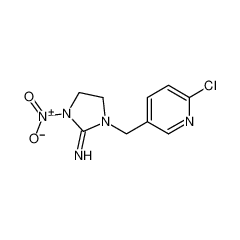
CAS No.: 138261-41-3 Formula: C9H10ClN5O2
Weight: 255.66100
Synonyms: 1-((6-chloropyridin-3-yl)methyl)-3-nitroimidazolidin-2-imine;
Imidacloprid is a systemic insecticide which acts as an insect neurotoxin and belongs to a class of chemicals called the neonicotinoids which act on the central nervous system of insects, with much lower toxicity to mammals. The chemical works by interfering with the transmission of stimuli in the insect nervous system. Specifically, it causes a blockage of the nicotinergic neuronal pathway. By blocking nicotinic acetylcholine receptors, imidacloprid prevents acetylcholine from transmitting impulses between nerves, resulting in the insect's paralysis and eventual death. It is effective on contact and via stomach action. Because imidacloprid binds much more strongly to insect neuron receptors than to mammal neuron receptors, this insecticide is more toxic to insects than to mammals. As of 1999, Imidacloprid was the most widely used insecticide in the world. Although it is now off patent, the primary manufacturer of this chemical is Bayer CropScience (part of Bayer AG). It is sold under many names for many uses; it can be applied by soil injection, tree injection, application to the skin of the plant, broadcast foliar, ground application as a granular or liquid formulation, or as a pesticide-coated seed treatment. Imidacloprid is widely used for pest control in agriculture. Other uses include application to foundations to prevent termite damage, pest control for gardens and turf, treatment of domestic pets to control fleas, protection of trees from boring insects, and in preservative treatment of some types of lumber products (e.g., Ecolife brand). Recent research suggests that widespread agricultural use of imidacloprid and other pesticides may be contributing to honey bee colony collapse disorder, the decline of honey bee colonies in Europe and North America observed since 2006. As a result, several countries have restricted use of imidacloprid and other neonicotinoids. In January 2013, the European Food Safety Authority stated that neonicotinoids pose an unacceptably high risk to bees, and that the industry-sponsored science upon which regulatory agencies' claims of safety have relied, may be flawed, or even deceptive.